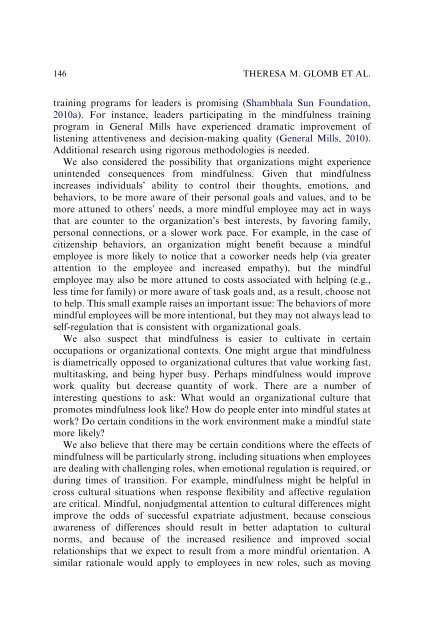Mindfulness at work (Glomb, Duffy et al, 2012) - Human Resources
Mindfulness at work (Glomb, Duffy et al, 2012) - Human Resources
Mindfulness at work (Glomb, Duffy et al, 2012) - Human Resources
Create successful ePaper yourself
Turn your PDF publications into a flip-book with our unique Google optimized e-Paper software.
146THERESA M. GLOMB ET AL.training programs for leaders is promising (Shambh<strong>al</strong>a Sun Found<strong>at</strong>ion,2010a). For instance, leaders particip<strong>at</strong>ing in the mindfulness trainingprogram in Gener<strong>al</strong> Mills have experienced dram<strong>at</strong>ic improvement oflistening <strong>at</strong>tentiveness and decision-making qu<strong>al</strong>ity (Gener<strong>al</strong> Mills, 2010).Addition<strong>al</strong> research using rigorous m<strong>et</strong>hodologies is needed.We <strong>al</strong>so considered the possibility th<strong>at</strong> organiz<strong>at</strong>ions might experienceunintended consequences from mindfulness. Given th<strong>at</strong> mindfulnessincreases individu<strong>al</strong>s’ ability to control their thoughts, emotions, andbehaviors, to be more aware of their person<strong>al</strong> go<strong>al</strong>s and v<strong>al</strong>ues, and to bemore <strong>at</strong>tuned to others’ needs, a more mindful employee may act in waysth<strong>at</strong> are counter to the organiz<strong>at</strong>ion’s best interests, by favoring family,person<strong>al</strong> connections, or a slower <strong>work</strong> pace. For example, in the case ofcitizenship behaviors, an organiz<strong>at</strong>ion might benefit because a mindfulemployee is more likely to notice th<strong>at</strong> a co<strong>work</strong>er needs help (via gre<strong>at</strong>er<strong>at</strong>tention to the employee and increased emp<strong>at</strong>hy), but the mindfulemployee may <strong>al</strong>so be more <strong>at</strong>tuned to costs associ<strong>at</strong>ed with helping (e.g.,less time for family) or more aware of task go<strong>al</strong>s and, as a result, choose notto help. This sm<strong>al</strong>l example raises an important issue: The behaviors of moremindful employees will be more intention<strong>al</strong>, but they may not <strong>al</strong>ways lead toself-regul<strong>at</strong>ion th<strong>at</strong> is consistent with organiz<strong>at</strong>ion<strong>al</strong> go<strong>al</strong>s.We <strong>al</strong>so suspect th<strong>at</strong> mindfulness is easier to cultiv<strong>at</strong>e in certainoccup<strong>at</strong>ions or organiz<strong>at</strong>ion<strong>al</strong> contexts. One might argue th<strong>at</strong> mindfulnessis diam<strong>et</strong>ric<strong>al</strong>ly opposed to organiz<strong>at</strong>ion<strong>al</strong> cultures th<strong>at</strong> v<strong>al</strong>ue <strong>work</strong>ing fast,multitasking, and being hyper busy. Perhaps mindfulness would improve<strong>work</strong> qu<strong>al</strong>ity but decrease quantity of <strong>work</strong>. There are a number ofinteresting questions to ask: Wh<strong>at</strong> would an organiz<strong>at</strong>ion<strong>al</strong> culture th<strong>at</strong>promotes mindfulness look like? How do people enter into mindful st<strong>at</strong>es <strong>at</strong><strong>work</strong>? Do certain conditions in the <strong>work</strong> environment make a mindful st<strong>at</strong>emore likely?We <strong>al</strong>so believe th<strong>at</strong> there may be certain conditions where the effects ofmindfulness will be particularly strong, including situ<strong>at</strong>ions when employeesare de<strong>al</strong>ing with ch<strong>al</strong>lenging roles, when emotion<strong>al</strong> regul<strong>at</strong>ion is required, orduring times of transition. For example, mindfulness might be helpful incross cultur<strong>al</strong> situ<strong>at</strong>ions when response flexibility and affective regul<strong>at</strong>ionare critic<strong>al</strong>. Mindful, nonjudgment<strong>al</strong> <strong>at</strong>tention to cultur<strong>al</strong> differences mightimprove the odds of successful exp<strong>at</strong>ri<strong>at</strong>e adjustment, because consciousawareness of differences should result in b<strong>et</strong>ter adapt<strong>at</strong>ion to cultur<strong>al</strong>norms, and because of the increased resilience and improved soci<strong>al</strong>rel<strong>at</strong>ionships th<strong>at</strong> we expect to result from a more mindful orient<strong>at</strong>ion. Asimilar r<strong>at</strong>ion<strong>al</strong>e would apply to employees in new roles, such as moving


